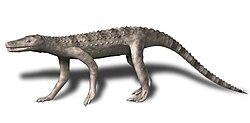| Sphenosuchia Temporal range: Late Triassic - Late Jurassic, | |
|---|---|
 | |
| Life restoration of Hesperosuchus agilis | |
 | |
| Skeletal diagram of Pseudhesperosuchus | |
| Scientific classification | |
| Kingdom: | Animalia |
| Phylum: | Chordata |
| Class: | Reptilia |
| Clade: | Archosauria |
| Clade: | Pseudosuchia |
| Clade: | Crocodylomorpha |
| Informal group: | † Sphenosuchia von Huene, 1942 |
| Genera | |
| Synonyms | |
| |
Sphenosuchia is a grouping of basal crocodylomorphs that first appeared in the Triassic and persisted into the Jurassic. Most were small, gracile animals with an erect limb posture. Although sometimes recovered as a monophyletic group, they are now generally thought to represent various early offshoots of the lineage leading to Crocodyliformes, with some sphenosuchians more closely related to crocodyliforms than to other "sphenosuchians", rendering the group paraphyletic.






